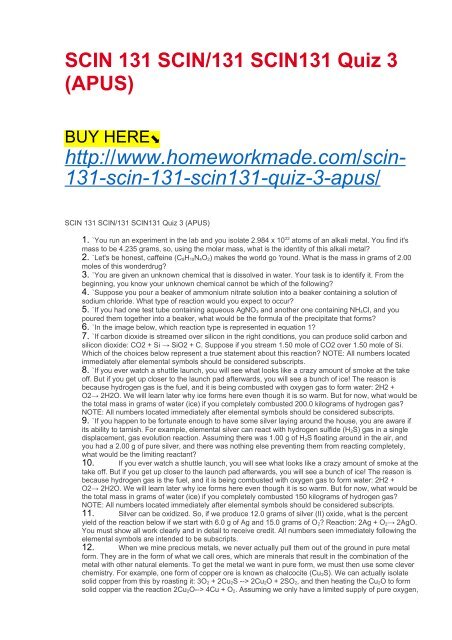SCIN 131 SCIN:131 SCIN131 Quiz 3 (APUS)
You also want an ePaper? Increase the reach of your titles
YUMPU automatically turns print PDFs into web optimized ePapers that Google loves.
<strong>SCIN</strong> <strong>131</strong> <strong>SCIN</strong>/<strong>131</strong> <strong>SCIN</strong><strong>131</strong> <strong>Quiz</strong> 3<br />
(<strong>APUS</strong>)<br />
BUY HERE⬊<br />
http://www.homeworkmade.com/scin-<br />
<strong>131</strong>-scin-<strong>131</strong>-scin<strong>131</strong>-quiz-3-apus/<br />
<strong>SCIN</strong> <strong>131</strong> <strong>SCIN</strong>/<strong>131</strong> <strong>SCIN</strong><strong>131</strong> <strong>Quiz</strong> 3 (<strong>APUS</strong>)<br />
1. `You run an experiment in the lab and you isolate 2.984 x 10 22 atoms of an alkali metal. You find it's<br />
mass to be 4.235 grams, so, using the molar mass, what is the identity of this alkali metal?<br />
2. `Let's be honest, caffeine (C 8H 10N 4O 2) makes the world go 'round. What is the mass in grams of 2.00<br />
moles of this wonderdrug?<br />
3. `You are given an unknown chemical that is dissolved in water. Your task is to identify it. From the<br />
beginning, you know your unknown chemical cannot be which of the following?<br />
4. `Suppose you pour a beaker of ammonium nitrate solution into a beaker containing a solution of<br />
sodium chloride. What type of reaction would you expect to occur?<br />
5. `If you had one test tube containing aqueous AgNO 3 and another one containing NH 4Cl, and you<br />
poured them together into a beaker, what would be the formula of the precipitate that forms?<br />
6. `In the image below, which reaction type is represented in equation 1?<br />
7. `If carbon dioxide is streamed over silicon in the right conditions, you can produce solid carbon and<br />
silicon dioxide: CO2 + Si → SiO2 + C. Suppose if you stream 1.50 mole of CO2 over 1.50 mole of Si.<br />
Which of the choices below represent a true statement about this reaction? NOTE: All numbers located<br />
immediately after elemental symbols should be considered subscripts.<br />
8. `If you ever watch a shuttle launch, you will see what looks like a crazy amount of smoke at the take<br />
off. But if you get up closer to the launch pad afterwards, you will see a bunch of ice! The reason is<br />
because hydrogen gas is the fuel, and it is being combusted with oxygen gas to form water: 2H2 +<br />
O2→ 2H2O. We will learn later why ice forms here even though it is so warm. But for now, what would be<br />
the total mass in grams of water (ice) if you completely combusted 200.0 kilograms of hydrogen gas?<br />
NOTE: All numbers located immediately after elemental symbols should be considered subscripts.<br />
9. `If you happen to be fortunate enough to have some silver laying around the house, you are aware if<br />
its ability to tarnish. For example, elemental silver can react with hydrogen sulfide (H 2S) gas in a single<br />
displacement, gas evolution reaction. Assuming there was 1.00 g of H 2S floating around in the air, and<br />
you had a 2.00 g of pure silver, and there was nothing else preventing them from reacting completely,<br />
what would be the limiting reactant?<br />
10. If you ever watch a shuttle launch, you will see what looks like a crazy amount of smoke at the<br />
take off. But if you get up closer to the launch pad afterwards, you will see a bunch of ice! The reason is<br />
because hydrogen gas is the fuel, and it is being combusted with oxygen gas to form water: 2H2 +<br />
O2→ 2H2O. We will learn later why ice forms here even though it is so warm. But for now, what would be<br />
the total mass in grams of water (ice) if you completely combusted 150 kilograms of hydrogen gas?<br />
NOTE: All numbers located immediately after elemental symbols should be considered subscripts.<br />
11. Silver can be oxidized. So, if we produce 12.0 grams of silver (II) oxide, what is the percent<br />
yield of the reaction below if we start with 6.0 g of Ag and 15.0 grams of O 2? Reaction: 2Ag + O 2→ 2AgO.<br />
You must show all work clearly and in detail to receive credit. All numbers seen immediately following the<br />
elemental symbols are intended to be subscripts.<br />
12. When we mine precious metals, we never actually pull them out of the ground in pure metal<br />
form. They are in the form of what we call ores, which are minerals that result in the combination of the<br />
metal with other natural elements. To get the metal we want in pure form, we must then use some clever<br />
chemistry. For example, one form of copper ore is known as chalcocite (Cu 2S). We can actually isolate<br />
solid copper from this by roasting it: 3O 2 + 2Cu 2S --> 2Cu 2O + 2SO 2, and then heating the Cu 2O to form<br />
solid copper via the reaction 2Cu 2O--> 4Cu + O 2. Assuming we only have a limited supply of pure oxygen,
what is the limiting reagent in the first equation listed and percent yield of Cu overall if you are given 23.5<br />
g Cu 2S and 15.0 g O 2? You must show all work clearly and in detail to receive credit. All numbers<br />
immediately following elemental symbols should be understood as subscripts.

















